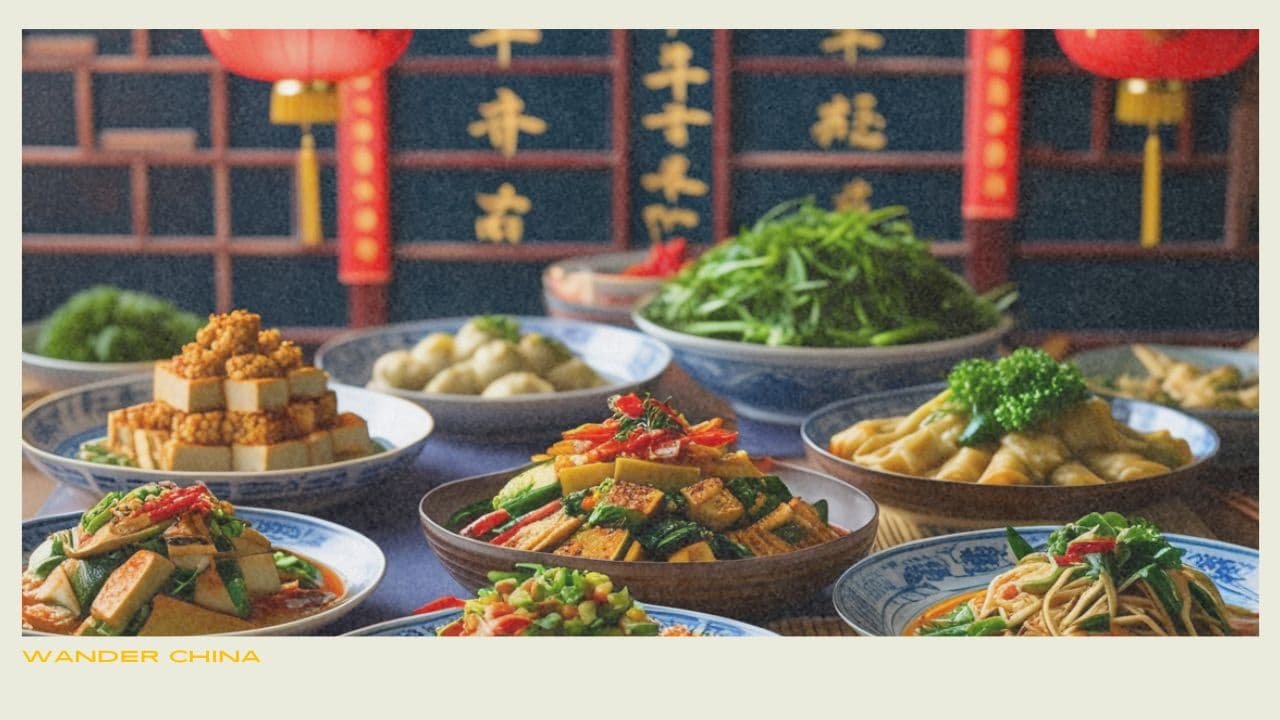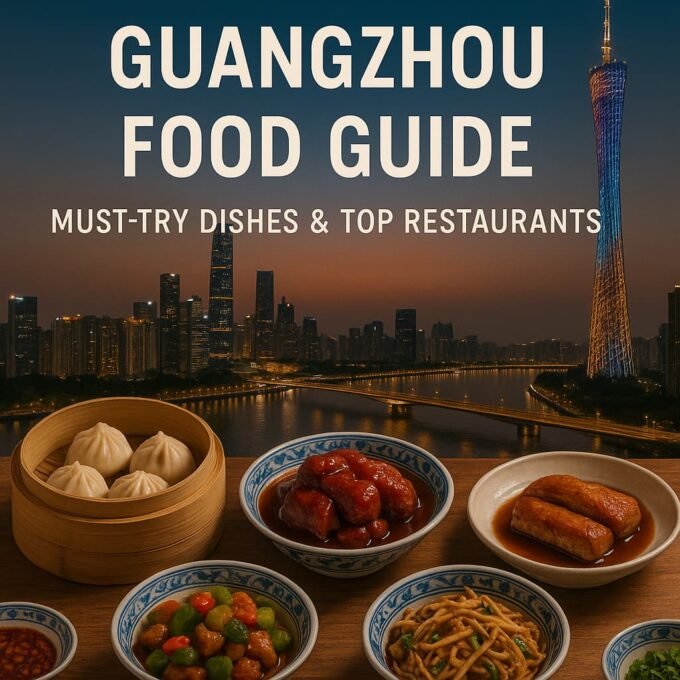From Tofu to Temple Food: Exploring China’s Vibrant Vegan Cuisine
Explore delicious vegan options in Chinese cuisine.

The Rise of Veganism in Chinese Cuisine
Veganism and plant-based diets have been gaining tremendous popularity worldwide in recent years, and China is no exception. While the concept of vegetarianism has deep roots in Chinese culture, dating back to ancient Buddhist and Taoist traditions, the modern vegan movement has brought a fresh perspective to traditional Chinese cuisine.
One of the primary driving forces behind the rise of veganism in China is a growing concern for personal health. As awareness of the potential health risks associated with consuming excessive amounts of meat and animal products increases, more Chinese consumers are turning to plant-based alternatives. Vegan diets have been shown to reduce the risk of chronic diseases such as heart disease, diabetes, and certain types of cancer.
Environmental considerations have also played a significant role in the popularization of veganism in China. The country’s rapid industrialization and urbanization have led to severe environmental challenges, including air pollution, water scarcity, and deforestation. By adopting a plant-based diet, individuals can significantly reduce their carbon footprint and contribute to a more sustainable future.
Ethical concerns regarding animal welfare have also contributed to the growth of veganism in China. As awareness of the often inhumane conditions in which animals are raised for food production increases, more people are choosing to abstain from consuming animal products as a form of compassion and respect for all living beings.
Furthermore, the rise of social media and the internet has facilitated the spread of information about veganism and its benefits, making it more accessible and appealing to a wider audience in China. Influential vegan bloggers, activists, and celebrities have played a crucial role in promoting plant-based lifestyles and inspiring others to make the switch.
Traditional Chinese Vegan Dishes
The roots of vegan cuisine in China can be traced back centuries, deeply intertwined with Buddhist philosophy and its emphasis on compassion for all living beings. The concept of “zhai cai,” or vegetarian dishes, has been an integral part of Chinese culinary traditions for over a millennium.
Buddhist monks were among the pioneers of plant-based cooking in China, crafting creative and flavorful dishes using only vegetables, grains, and legumes. Their culinary innovations were driven by the need to adhere to the Buddhist principles of non-violence and respect for life. Over time, these vegetarian dishes evolved into a sophisticated and diverse cuisine, celebrated for its rich flavors and ingenious techniques.
One of the hallmarks of traditional Chinese vegan cuisine is the use of mock meats, also known as “vegetarian meat substitutes.” These plant-based alternatives mimic the texture and flavor of various meats, allowing for the creation of familiar and beloved dishes without the use of animal products. Mock meats can be made from a variety of ingredients, including soy, wheat gluten, mushrooms, and even vegetables like eggplant or tofu.
Vegetable preparations in Chinese vegan cuisine are equally impressive, showcasing the versatility and creativity of the chefs. Techniques like stir-frying, steaming, and braising are employed to bring out the natural flavors and textures of vegetables, while intricate knife skills transform humble ingredients into visually stunning dishes. From delicate vegetable carvings to hearty stews, the range of vegan dishes in Chinese cuisine is truly remarkable.
Regional Variations in Chinese Vegan Cuisine
Chinese cuisine is renowned for its diversity, with each region boasting its unique flavors, ingredients, and cooking techniques. This diversity extends to vegan Chinese cuisine, where regional variations play a significant role in shaping the culinary experience.
In the fiery Sichuan region, vegan dishes are characterized by their bold and numbing flavors. Chili peppers, Sichuan peppercorns, and fermented bean pastes are heavily used, creating dishes that pack a punch. Mapo tofu, a classic Sichuan dish, can be easily veganized by substituting the meat with plant-based protein sources like mushrooms or soy-based meat alternatives.
Cantonese cuisine, on the other hand, is known for its subtlety and delicate flavors. Vegan Cantonese dishes often feature fresh vegetables, mushrooms, and tofu, with a focus on preserving the natural flavors of the ingredients. Steaming and stir-frying are common cooking methods, allowing the vegetables to retain their crunch and vibrant colors.
In the northern regions of China, vegan dishes tend to be heartier and more filling. Wheat-based products like noodles, dumplings, and buns are prevalent, often filled with vegetable or plant-based protein fillings. Beijing’s famous mock meat dishes, made from gluten or soy, are a testament to the region’s creativity in replicating the textures and flavors of meat using plant-based ingredients.
The coastal regions of China, such as Fujian and Zhejiang, have a strong influence from Buddhist cuisine, which emphasizes vegetarian and vegan dishes. These regions are known for their use of fresh seafood substitutes like mock shrimp made from vegetables or plant-based proteins.
Across China, the use of different ingredients and cooking techniques creates a diverse and flavorful vegan culinary landscape. From the spicy and numbing flavors of Sichuan to the delicate and subtle tastes of Cantonese cuisine, each region offers a unique perspective on vegan Chinese cuisine, catering to various palates and dietary preferences.
Popular Vegan Chinese Dishes
Chinese cuisine offers a wealth of delicious and satisfying vegan options that have been enjoyed for centuries. Here are some of the most popular and beloved vegan Chinese dishes:
Mapo Tofu
Mapo tofu is a classic Sichuan dish that features tender cubes of tofu swimming in a rich, spicy sauce made with fermented bean paste, chili oil, and Sichuan peppercorns. Despite its fiery appearance, the dish has a depth of flavor that goes beyond mere heat. To make a vegan version, simply omit the ground pork and use vegetable broth instead of chicken broth.
Buddha’s Delight
Buddha’s Delight, also known as Jai or Lo Han Zhai, is a beloved vegetarian dish that celebrates the bounty of the season. It typically includes a variety of sautéed or braised vegetables, such as mushrooms, bamboo shoots, water chestnuts, and baby corn, flavored with soy sauce, rice wine, and sesame oil. This dish is a staple during Chinese New Year and other Buddhist festivals.
Vegetable Dumplings
Dumplings are a beloved part of Chinese cuisine, and vegan versions are easy to find or make at home. Vegetable dumplings can be filled with a variety of ingredients, such as cabbage, carrots, mushrooms, and tofu, seasoned with ginger, garlic, and soy sauce. They can be steamed, boiled, or pan-fried, and served with a dipping sauce like soy sauce, vinegar, or chili oil.
Kung Pao Vegetables
Kung Pao is a classic Sichuan dish that traditionally features chicken, but it can be easily adapted to a vegan version by substituting vegetables like bell peppers, mushrooms, and water chestnuts. The vegetables are stir-fried with Sichuan peppercorns, chili peppers, garlic, and a savory sauce made with soy sauce, rice vinegar, and sugar.
Vegetable Chow Mein
Chow mein, a popular Chinese noodle dish, can be made vegan by using vegetable broth instead of chicken broth and omitting any meat or seafood. The noodles are stir-fried with a variety of fresh vegetables, such as cabbage, carrots, bean sprouts, and mushrooms, and flavored with soy sauce, garlic, and ginger.
These are just a few examples of the many delicious vegan Chinese dishes available. With a little creativity and the right ingredients, you can enjoy the flavors and textures of traditional Chinese cuisine without compromising your dietary preferences.
Vegan Versions of Classic Chinese Dishes
As the demand for plant-based options continues to rise, many traditional Chinese dishes have been reimagined with vegan-friendly ingredients. These vegan versions not only cater to those following a meat-free lifestyle but also offer a healthier and more sustainable alternative to classic Chinese cuisine.
One of the most popular vegan adaptations is the vegan sweet and sour “pork.” Instead of using pork, this dish typically features plant-based protein sources like seitan, tofu, or soy-based meat alternatives. The sweet and tangy sauce is made from a combination of vinegar, sugar, and various seasonings, giving it that signature flavor profile. To mimic the texture of pork, the plant-based protein is often battered and fried before being tossed in the sauce.
Another classic dish that has received a vegan makeover is kung pao “chicken.” In this vegan version, the chicken is replaced with plant-based protein sources such as soy-based chicken alternatives or crispy baked tofu. The iconic kung pao sauce, made with soy sauce, vinegar, chili peppers, and roasted peanuts, remains largely unchanged, providing the dish with its signature bold and spicy flavors.
Beef and broccoli is another beloved Chinese dish that has been veganized. Instead of beef, this vegan version utilizes plant-based beef alternatives or hearty mushrooms like portobello or oyster mushrooms. The broccoli florets are cooked to perfection and combined with the plant-based protein in a savory sauce made from soy sauce, garlic, and ginger, creating a dish that is both satisfying and nutritious.
In addition to these classic dishes, many other traditional Chinese recipes have been adapted to accommodate vegan diets. From vegan dumplings and spring rolls to plant-based versions of Szechuan and Hunan dishes, the possibilities are endless. Plant-based protein alternatives like tofu, tempeh, and seitan have become staples in vegan Chinese cuisine, allowing for a wide range of textures and flavors to be explored.
Flavor substitutions also play a crucial role in veganizing Chinese dishes. For example, instead of using eggs to bind or thicken sauces, vegan alternatives like cornstarch or arrowroot powder can be used. Vegan oyster sauce, made from mushrooms, provides a rich umami flavor, while vegan fish sauce, made from fermented soy or seaweed, adds depth and complexity to dishes.
Overall, the rise of vegan Chinese cuisine has opened up a world of possibilities for those seeking plant-based alternatives to traditional dishes. With creative ingredient substitutions and a focus on bold flavors, these vegan versions offer a delicious and sustainable way to enjoy the rich culinary heritage of Chinese cuisine.
Vegan-Friendly Chinese Restaurants
The rise of veganism has not gone unnoticed in the Chinese culinary world, with an increasing number of restaurants catering to plant-based diets. Both in China and internationally, vegan-friendly Chinese eateries are sprouting up, offering delicious and innovative takes on traditional dishes.
In major cities like Beijing and Shanghai, restaurants like King’s Joy Vegetarian and Bao Ge Vegan have gained popularity for their flavorful and authentic vegan fare. King’s Joy Vegetarian, in particular, has garnered praise for its extensive menu featuring mock meats and creative plant-based interpretations of classic dishes like kung pao “chicken” and mapo tofu.
Internationally, cities with large Chinese communities have also seen a surge in vegan Chinese restaurants. In New York City, Buddha Bodai and Vegetarian Dim Sum House have become go-to spots for those seeking plant-based dumplings, noodles, and other Chinese favorites. Buddha Bodai’s extensive menu and commitment to using high-quality ingredients have earned it a loyal following among vegans and non-vegans alike.
In Los Angeles, Veggie Grill and Ramen Hood have gained popularity for their vegan takes on Chinese-American staples like orange “chicken” and ramen. Ramen Hood, in particular, has garnered praise for its creative and flavorful vegan ramen broths, which showcase the versatility of plant-based ingredients.
These restaurants not only cater to the growing vegan population but also offer a glimpse into the future of Chinese cuisine, where plant-based dishes are celebrated for their flavors and nutritional benefits, rather than being viewed as mere substitutes for meat-based dishes.
Nutritional Benefits of Vegan Chinese Cuisine
Vegan Chinese cuisine offers a wealth of nutritional benefits, thanks to its emphasis on plant-based ingredients. One of the most significant advantages is the abundance of plant-based proteins found in dishes featuring tofu, tempeh, edamame, and various legumes. These protein sources are not only cholesterol-free but also rich in fiber, which aids in digestion and promotes a feeling of fullness, making it easier to maintain a healthy weight.
Additionally, vegan Chinese cuisine is packed with a diverse array of vegetables, which provide essential vitamins, minerals, and antioxidants. Leafy greens like bok choy and Chinese broccoli are excellent sources of vitamins A, C, and K, as well as folate and iron. Cruciferous vegetables like cabbage and Brussels sprouts are rich in fiber and compounds that may help prevent certain types of cancer.
Furthermore, many vegan Chinese dishes incorporate whole grains, such as brown rice, quinoa, and buckwheat noodles, which provide complex carbohydrates, fiber, and various B vitamins. These grains help regulate blood sugar levels and promote a feeling of satiety, making it easier to maintain a balanced diet.
While some may be concerned about getting enough protein on a vegan diet, vegan Chinese cuisine offers a variety of protein-rich options. Combining different plant-based protein sources, such as tofu and legumes, can provide all the essential amino acids needed for optimal health.
Overall, vegan Chinese cuisine is a nutritional powerhouse, offering a diverse range of plant-based proteins, fiber, vitamins, minerals, and antioxidants. By embracing this cuisine, individuals can enjoy delicious and satisfying meals while reaping the numerous health benefits associated with a plant-based diet.
Challenges and Misconceptions
One of the biggest misconceptions about vegan Chinese cuisine is that it lacks flavor and variety. Many people associate traditional Chinese dishes with ingredients like meat, fish, and eggs, assuming that removing these components would result in bland and uninteresting meals. However, this couldn’t be further from the truth.
Chinese cuisine is renowned for its intricate flavors and ingenious use of spices, aromatics, and cooking techniques. Vegan dishes can be just as flavorful and diverse as their non-vegan counterparts, with the added benefit of being healthier and more environmentally friendly.
Another challenge that some may face is the perception that vegan Chinese cuisine is difficult or time-consuming to prepare. While it’s true that some dishes may require more preparation or specialized ingredients, there are plenty of simple and approachable options for home cooks or those seeking vegan options at restaurants.
To overcome these challenges and misconceptions, it’s important to approach vegan Chinese cuisine with an open mind and a willingness to explore new flavors and techniques. Experiment with different plant-based proteins, such as tofu, seitan, or tempeh, and don’t be afraid to use bold spices and seasonings to add depth and complexity to your dishes.
Additionally, seek out reputable recipes and resources from experienced vegan chefs or those well-versed in Chinese cuisine. Many traditional dishes can be easily adapted to be vegan-friendly with a few simple substitutions or modifications.
Ultimately, vegan Chinese cuisine offers a rich and diverse culinary experience that can satisfy even the most discerning palates. By embracing the flavors and techniques of this ancient cuisine, you can enjoy delicious, nutritious, and ethical meals that celebrate the bounty of plant-based ingredients.
Vegan Chinese Cooking at Home
For those looking to explore the world of vegan Chinese cuisine from the comfort of their own kitchens, the possibilities are endless. With a few simple ingredient swaps and cooking techniques, you can recreate your favorite Chinese dishes with a plant-based twist.
One of the keys to successful vegan Chinese cooking is mastering the art of ingredient substitution. Tofu, seitan, and mushrooms make excellent replacements for meat in dishes like kung pao “chicken,” mapo tofu, and vegetable lo mein. Coconut milk or cashew cream can be used in place of dairy products, while egg replacers like aquafaba (the liquid from canned chickpeas) can be used for binding and leavening.
Flavor is paramount in Chinese cuisine, and vegan cooking is no exception. Stock up on essential ingredients like soy sauce, rice vinegar, sesame oil, and a variety of spices and aromatics like ginger, garlic, and chili peppers. These ingredients will help you achieve the bold, umami-rich flavors that define Chinese cuisine.
Cooking techniques also play a crucial role in creating authentic-tasting vegan Chinese dishes. Stir-frying, steaming, and braising are all common methods used in Chinese cooking, and they can be easily adapted to plant-based ingredients. For example, stir-frying tofu or vegetables in a hot wok with a flavorful sauce can mimic the texture and flavor of traditional meat-based dishes.
If you’re new to vegan Chinese cooking, don’t be afraid to seek out recipes and guidance from experienced vegan bloggers and chefs. Many have dedicated themselves to perfecting plant-based versions of classic Chinese dishes, and their websites and cookbooks are treasure troves of delicious and approachable recipes.
Some popular vegan Chinese recipe sources include:
- “The Buddhist Chef” by Smita Saran, featuring veganized versions of traditional Buddhist temple cuisine
- “The Chinese Vegan Kitchen” by Donna Klein, with recipes inspired by regional Chinese cuisines
- “The Vegan Chinese Kitchen” by Christine Wong, offering modern twists on classic dishes
- The “Woon Heng” YouTube channel, showcasing authentic Singaporean and Malaysian vegan dishes
With a little creativity and a willingness to experiment, you can bring the flavors of vegan Chinese cuisine into your own kitchen, creating delicious and satisfying meals that are sure to impress even the most discerning palates.
The Future of Vegan Chinese Cuisine
The future of vegan Chinese cuisine looks promising, with exciting trends and developments on the horizon. One notable trend is the increasing use of plant-based meat alternatives, such as soy-based or pea-based protein products, in traditional Chinese dishes. These meat substitutes are becoming more realistic in texture and flavor, allowing vegan diners to enjoy familiar dishes without compromising on taste or authenticity.
Another exciting development is the rise of innovative ingredient combinations and fusion cuisine. Chefs are experimenting with unconventional ingredients and flavors, blending traditional Chinese techniques with global culinary influences. This fusion approach has led to the creation of unique and creative vegan dishes that appeal to both plant-based and omnivorous diners.
Moreover, the growing popularity of vegan Chinese cuisine is driving increased demand and accessibility. As more restaurants and food establishments recognize the potential of this market, they are expanding their vegan offerings and catering to diverse dietary preferences. This trend is particularly evident in major cities and urban areas, where vegan-friendly Chinese restaurants and food trucks are flourishing.
Looking ahead, the future of vegan Chinese cuisine is poised for continued growth and innovation. With the rise of environmental consciousness and health-conscious consumers, plant-based diets are becoming increasingly mainstream. Chinese cuisine, with its rich history and diverse regional variations, offers a fertile ground for exploring vegan options and pushing the boundaries of flavor and creativity.
As the demand for vegan Chinese cuisine continues to rise, we can expect to see more investment in research and development, leading to improved plant-based ingredients, innovative cooking techniques, and a deeper understanding of the nutritional benefits of this culinary tradition. Ultimately, the future of vegan Chinese cuisine promises to be a delicious and sustainable journey, one that celebrates the rich heritage of Chinese cuisine while embracing the ethical and environmental values of a plant-based lifestyle.
Recent Posts
- Top Guangzhou Watch Markets to Visit in 2025: The Ultimate Insider’s Guide
- My Guide to the Best Home Appliance Markets in Guangzhou
- Guangzhou Garment Wholesale Markets: My Local Guide
- Best Hotel in Guangzhou: A Comprehensive Guide for Foreign Travelers
- Guangzhou Food Guide: Must-Try Dishes & Top Restaurants (2025 Edition)
Recent Comments
Top Guangzhou Watch Markets to Visit in 2025: The Ultimate Insider’s Guide
I visited the top watch markets in Guangzhou to show you where...
My Guide to the Best Home Appliance Markets in Guangzhou
Explore top offline home appliance markets in Guangzhou with local tips, Chinese...
Best Hotel in Guangzhou: A Comprehensive Guide for Foreign Travelers
Find the best hotels in Guangzhou—from luxury icons to local favorites. Updated...
Guangzhou Food Guide: Must-Try Dishes & Top Restaurants (2025 Edition)
I’m an expat in Guangzhou sharing the best local dishes, top restaurants...







Leave a comment